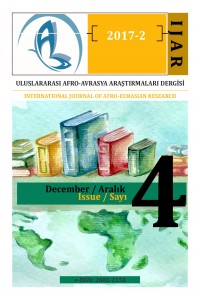Öz
Legends, one of the products that hold the most place in the cultural memory of the Turkish society, comes out as a bearer of many traditions of tradition in terms of credibility and short-term formation. One of the materials conveyed by cultural transmission is taboos. The taboos, which can be defined as myth bans, is the first law of mankind without writing. This work, which was made on the first legislation, definitions of legends and taboos, the relevance of the taboo word to the origin and linguistics and on the taboos were brought to the body based on the classifications of different researchers. The taboos in the legends are constituted Stith Thompson's Motif Index of Folk Literature, which is based on the prohibitions shown with ″C″
Anahtar Kelimeler
Kaynakça
- Abdulla, Kamal (2012), Mitten Yazıya veya Gizli Dede Korkut, Çev. Ali Duymaz, Ötüken Neşriyat, Ankara.
- Alptekin, Ali Berat (2012), Efsane ve Motifleri Üzerine, Akçağ Yayınları, Ankara.
- Boratav, Pertev Naili (2000), 100 Soruda Türk Halk Edebiyatı, Gerçek Yayınevi, İstanbul.
- Çağatay, Saadet (1974), ″Türklerde Bâtıl İnançlar Arasında Tabu″, I. Uluslararası Türk Folklor Semineri Bildirileri, s.365-372, Ankara.
- Çobanoğlu, Özkul (2015), Türk Halk Kültüründe Memoratlar ve Halk İnançları, Akçağ Yayınevi, Ankara.
- Demirci, Kerim (2008), ″Örtmece (Euphemism) Kavramı Üzerine″, Milli Folklor, S.77, s.21-34, Ankara.
- Demirtaş, Sezai (2013), ‘’Savaş ve Fetih Olguları Bağlamında Anadolu Sahası Türk Efsaneleri Üzerine İncelemeler’’, Yayımlanmamış Yüksek Lisans Tezi, Selçuk Üniversitesi Sosyal Bilimler Enstitüsü, Konya.
- Ergin, Muharrem (2004), Dede Korkut Kitabı, C. 1, Türk Dil Kurumu Yayınları, Ankara.
- Ergun, Metin (1997), Türk Dünyası Efsanelerinde Değişme Motifi, C. 2, Türk Dil Kurumu Yayınları, Ankara.
- Freud, Sigmund (2014), Totem ve Tabu, Tutku Yayınevi, Ankara.
- Kahraman, Seyit Ali – DAĞLI, Yücel (2006), Günümüz Türkçesi ile Evliyâ Çelebi Seyahatnâmesi: Konya-Kayseri-Antakya-Şam-Urfa-Maraş-Sivas-Gazze-Sofya-Edirne, C. 3, Yapı Kredi Yayınları, İstanbul.
- Karçığa, Servet (2016), ″Dede Korkut Kitabı’nda Örtmece Sözler Üzerine Bir İnceleme″, Internaional Journal of Language Academy, Vol. 4/1 Spring, s. 303-314, Finlandiya.
- Ögel, Bahaeddin (2014), Türk Mitolojisi (Kaynakları ve Açıklamaları İle Destanlar), C. 2, Ankara.
- Pehlivan, Gürol (2010), ″Anadolu’da Tabu İle İlgili Bir Tâbir: Düşmez″, Türk Dünyası İncelemeleri Dergisi, C. X, S.10, s.77, İzmir.
- Sakaoğlu, Saim (2009), Efsane Araştırmaları, Kömen Yayınları, Konya.
- Sakaoğlu, Saim (2014), 101 Türk Efsanesi, Akçağ Yayınları, Ankara.
- Tanyu, Hikmet (1984), ″Totem, Totemizm Ve Tabu Üzerinde Yeni Araştırmalar″, Ankara Üniversitesi İlâhiyat Fakültesi Dergisi, C. 26, S. 1, s. 168, Ankara.
- Tdk, (1998), Türkçe Sözlük, Türk Dil Kurumu Yayınları, Ankara.
Öz
Türk toplumunun kültürel belleğinde
en fazla yer tutan mahsullerden bir tanesi olan efsaneler, inandırıcılık
özelliği ve kısa nesir şeklindeki teşekkülü bakımından geleneğe ait pek çok
malzemenin taşıyıcısı olarak karşımıza çıkmaktadır. Kültürel aktarımla taşınan
malzemelerden bir tanesi de tabulardır. Mit yasakları olarak tanımlanabilecek
olan tabular, insanoğlunun yazısız ilk yasalarıdır. Bahsi geçen ilk yasalara
dair yapılan bu çalışma; efsane ve tabulara dair tanımlar, tabu kelimesinin
kökeni ve dilbilim ile olan alakası, tabular üzerinde farklı araştırmacıların
yaptığı tasnifler baz alınarak vücuda getirilmiştir. Efsanelerin muhtevasındaki
tabular ise Stith Thompson’un Motif-İndex of Folk Literature adlı çalışmasında,
‘’C’’ motif imgesi ile verilen yasaklar kısmı esas alınarak oluşturulmuştur.
Kaynakça
- Abdulla, Kamal (2012), Mitten Yazıya veya Gizli Dede Korkut, Çev. Ali Duymaz, Ötüken Neşriyat, Ankara.
- Alptekin, Ali Berat (2012), Efsane ve Motifleri Üzerine, Akçağ Yayınları, Ankara.
- Boratav, Pertev Naili (2000), 100 Soruda Türk Halk Edebiyatı, Gerçek Yayınevi, İstanbul.
- Çağatay, Saadet (1974), ″Türklerde Bâtıl İnançlar Arasında Tabu″, I. Uluslararası Türk Folklor Semineri Bildirileri, s.365-372, Ankara.
- Çobanoğlu, Özkul (2015), Türk Halk Kültüründe Memoratlar ve Halk İnançları, Akçağ Yayınevi, Ankara.
- Demirci, Kerim (2008), ″Örtmece (Euphemism) Kavramı Üzerine″, Milli Folklor, S.77, s.21-34, Ankara.
- Demirtaş, Sezai (2013), ‘’Savaş ve Fetih Olguları Bağlamında Anadolu Sahası Türk Efsaneleri Üzerine İncelemeler’’, Yayımlanmamış Yüksek Lisans Tezi, Selçuk Üniversitesi Sosyal Bilimler Enstitüsü, Konya.
- Ergin, Muharrem (2004), Dede Korkut Kitabı, C. 1, Türk Dil Kurumu Yayınları, Ankara.
- Ergun, Metin (1997), Türk Dünyası Efsanelerinde Değişme Motifi, C. 2, Türk Dil Kurumu Yayınları, Ankara.
- Freud, Sigmund (2014), Totem ve Tabu, Tutku Yayınevi, Ankara.
- Kahraman, Seyit Ali – DAĞLI, Yücel (2006), Günümüz Türkçesi ile Evliyâ Çelebi Seyahatnâmesi: Konya-Kayseri-Antakya-Şam-Urfa-Maraş-Sivas-Gazze-Sofya-Edirne, C. 3, Yapı Kredi Yayınları, İstanbul.
- Karçığa, Servet (2016), ″Dede Korkut Kitabı’nda Örtmece Sözler Üzerine Bir İnceleme″, Internaional Journal of Language Academy, Vol. 4/1 Spring, s. 303-314, Finlandiya.
- Ögel, Bahaeddin (2014), Türk Mitolojisi (Kaynakları ve Açıklamaları İle Destanlar), C. 2, Ankara.
- Pehlivan, Gürol (2010), ″Anadolu’da Tabu İle İlgili Bir Tâbir: Düşmez″, Türk Dünyası İncelemeleri Dergisi, C. X, S.10, s.77, İzmir.
- Sakaoğlu, Saim (2009), Efsane Araştırmaları, Kömen Yayınları, Konya.
- Sakaoğlu, Saim (2014), 101 Türk Efsanesi, Akçağ Yayınları, Ankara.
- Tanyu, Hikmet (1984), ″Totem, Totemizm Ve Tabu Üzerinde Yeni Araştırmalar″, Ankara Üniversitesi İlâhiyat Fakültesi Dergisi, C. 26, S. 1, s. 168, Ankara.
- Tdk, (1998), Türkçe Sözlük, Türk Dil Kurumu Yayınları, Ankara.
Ayrıntılar
| Bölüm | Makaleler |
|---|---|
| Yazarlar | |
| Yayımlanma Tarihi | 17 Aralık 2017 |
| Yayımlandığı Sayı | Yıl 2017 Cilt: 2 Sayı: 4 |
All rights reserved. International Journal of Afro-Eurasian Research (IJAR) is an International refereed journal and published biannually. Authors are responsible for the content and linguistic of their articles. Articles published here could not be used without referring to the Journal. The opinions in the articles published belong to the authors only and do not reflect those of International Journal of Afro-Eurasian Research.


